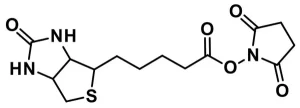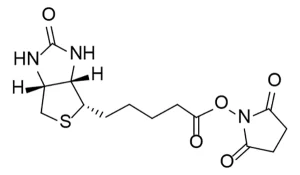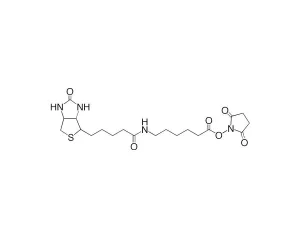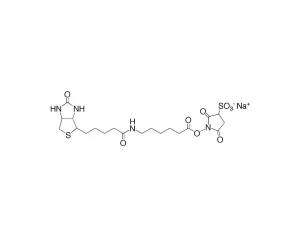Description
NHS-dPEG®24-biotin, product number QBD-10774, is an amine-reactive biotinylation product containing a single molecular weight, discrete PEG (dPEG®) linker that is 76 atoms long. Although biotin usually is poorly soluble in water, the amphiphilic dPEG® linker creates excellent water solubility while maintaining organic solvent solubility. The N-hydroxysuccinimidyl (NHS) moiety of NHS-dPEG®24-biotin reacts optimally with free primary amines in the pH range 7.0 – 7.5., forming stable amide bonds. Unlike the classic, hydrophobic biotin linkers, LC-biotin and LC-LC-biotin, NHS-PEG®24-biotin does not cause protein aggregation due to over-labeling of the target molecule. Labeling experiments, supramolecular construction, affinity chromatography, pull-down assays, the creation of biotinylated antibodies, and many other applications can use NHS-dPEG®24-biotin to take advantage of the exceptionally high affinity between biotin and avidin or streptavidin.
References
Greg T. Hermanson, Bioconjugate Techniques, 2nd Edition, Elsevier Inc., Burlington, MA 01803, April, 2008 (ISBN-13: 978-0-12-370501-3; ISBN-10: 0-12-370501-0). Specifically see pp. 726-730 in his chapter 18 on discrete PEG compounds for pegylation applications.
Greg T. Hermanson, Bioconjugate Techniques, 3rd Edition, Elsevier, Waltham, MA 02451, 2013, ISBN 978-0-12-382239-0; See Chapter 18, Discrete PEG Reagents, pp. 787-821, for a full overview of the dPEG® products.
Visualizing mechanical tension across membrane receptors with a fluorescent sensor. Daniel R Stabley, Carol Jurchenko, Stephen S Marshall & Khalid S Salaita. Nature Methods. 2011, 9, PP 64–67. October 30, 2011. doi:10.1038/nmeth.1747.
Hepatocyte Targeting of Nucleic Acid Complexes and Liposomes by a T7 Phage p17 Peptide. So C. Wong, Darren Wakefield, Jason Klein, Sean D. Monahan, David B. Rozema, David L. Lewis, Lori Higgs, James Ludtke, Alex V. Sokoloff, and Jon A. Wolff. Mol. Pharm. 2006, 3, (4) pp 386-397. March 28, 2006. DOI: 10.1021/mp050108r.
Visualizing mechanical tension across membrane receptors with a fluorescent sensor. Daniel R Stabley, Carol Jurchenko, Stephen S Marshall & Khalid S Salaita. Nature Method. 2012, 9 (1) pp 64-67. October 30, 2011. DOI:10.1038/nmeth.1747






